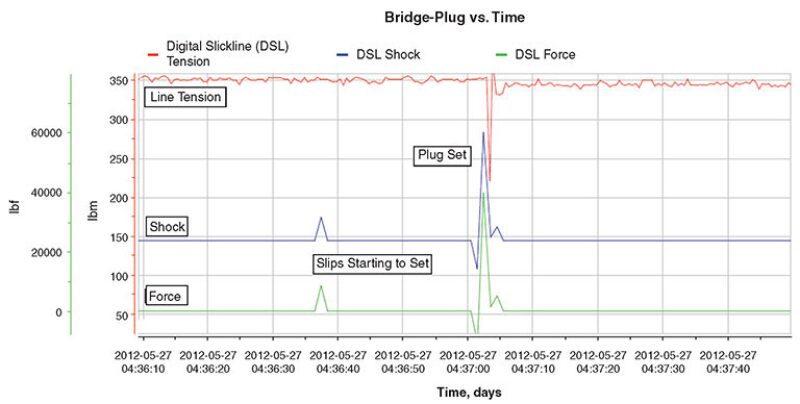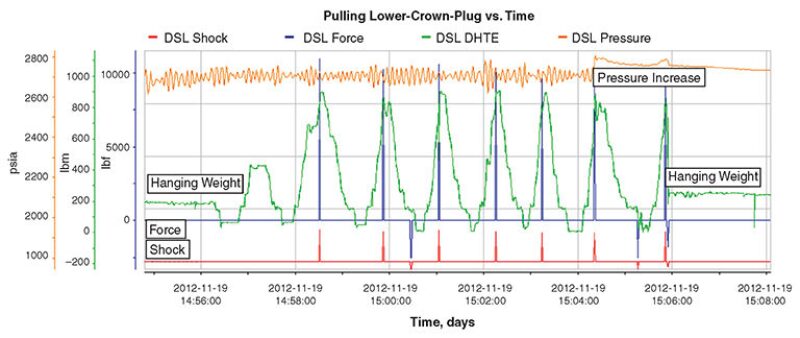Slicklines often play a vital role in offshore plug-and-abandonment (P&A) operations, either in those phases of the operation that require slickline conveyance or because logistical, footprint, operational, economical, environmental, or regulatory parameters of a P&A necessitate full reliance on this small, light, cost-effective conveyance offering. P&A activities using digital slickline increase equipment, logistic, and marine-support efficiency.
Introduction
Slickline-conveyance services have long been used in the exploration and production industry, with much of the slickline equipment, processes, and capabilities remaining relatively unchanged. Mechanical services have remained slickline’s mainstay. Evolutionary enhancements resulting from developments in metallurgical engineering are applied to the line itself and the mechanical tools deployed, along with improvements in pressure-control and winch technology used to deploy the tools and services safely in live wells. Oilfield application of battery-powered electronics in downhole tools began in the late 1970s, eventually including electronics-based devices such as gauges, firing heads, bottomhole-fluid samplers, and production-logging and caliper tools, as well as hydraulic tools. Slickline services were soon offered to both remedial services (pipe cutting, tubing punching, and perforating) and measurement services (production, pipe, and cement-bond-integrity logging). The demand for slickline services has remained steady over the years because of its many inherent advantages: minimal footprint; ease of logistics to, from, and on the wellsite; operational simplicity; and overall cost-effectiveness.
The demand for hydrocarbons and the resulting effect on oil prices led to active developments in the subsea and deepwater arenas in past years, resulting in an increased complexity of well placements and associated well completions. This has led subsequently to new and innovative well-intervention capabilities being devised (and the associated equipment being engineered, developed, and deployed) as the need for intervention in these well types has grown.
Cost management is also a key part of P&A operations, along with safe execution and quality outcomes. Enhancements to existing (and development of new) purpose-built vessels and equipment, coupled with an intervention workforce that is growing in relevant and multiskilled capabilities, are in high demand. Lightweight, low-footprint intervention systems can lower cost significantly if they can offer a broad range of services and can be deployed on lower-cost vessels.
Slickline services have most recently seen a move toward on-command services and job-recording capability through telemetry enablement of the slick wire, combined with purpose-built downhole tools and a computer command-and-acquisition system. With telemetry-enabled slickline, its real-time data acquisition and control capabilities enhance and expand not only the remedial and measurement services on offer through slickline conveyance, but also the more-routine mechanical services that make up the majority of slickline applications.
These capabilities of digital slickline are leveraged in the P&A arena, where advanced levels of clarity, certainty, and recordability are fully expected from all services used. These factors are also particularly sought after in high-cost, highly sensitive environments such as the Gulf of Mexico and for the more-complex situations of subsea completions and deepwater applications.
The digital-slickline trigger device used for all explosives-related services such as device activation (e.g., plugs and cement bailers), pipe cutting and punching, and perforating has been designed with a number of intrinsic safety features that were not previously available with slickline conveyance. The trigger is designed to ensure that triggering of the explosives cannot occur without a positive command from the surface-acquisition system. The correlation and eventual firing is managed with a single descent in the well. In addition, clear and concise shot detection is available on surface. This is visualized and recorded in real time from multiple sensors in the basic control cartridge as well as from additional sensors that may be included, depending on the tool-string configuration deployed.
Case Examples
The following examples discussed in this paper are from two single-well subsea P&A operations and a subsea-intervention operation recently carried out for two different customers in the Gulf of Mexico. In the P&A examples, where natural depletion and water encroachment had killed the well, there were no additional zones above to bring on line. Hence, it was concluded that the economic life of the well was spent, and as such the well was to be permanently abandoned. The overall well P&A process was typical: downhole sequence of cement-plug placement in the tubing and across the perforations; placement of bridge plugs and associated cement plugs in the tubing, casing, and associated annuli at the required depth points within the well; subsea-tree removal and the cutting and recovery of some completion components; casing cutting and removal at the prescribed depth below the mudline; and final site-clearance survey and completion certificate. The riserless intervention operations featured here required coordination of multiple service companies, each involved in a number of phases of the operation, working off a dynamically positioned multipurpose vessel with remotely-operated-vehicle capabilities for equipment placement and removal of the subsea components. In addition to the setting of the bridge plugs, there was also the need to punch the tubing or casing to enable the circulation necessary for the cement placement. Gauge cutter drift runs were also performed at various steps in the P&A sequence. High precision for the plug setting and perforation depths was needed to place the cement barriers successfully. However, limited deck space, coupled with the desire to minimize the time taken and logistics needed for equipment change out for certain service providers, led the customer to choose digital slickline above standard slickline, using this service to complete slickline and equivalent electric-line tasks.
The first operation was performed in 315 ft of water with a riser. Magna range bridge-plug placement and cement-dump bailing was carried out, with several runs performed to place the desired cement column. A number of gauge-ring drift runs were carried out, primarily for tubing-access confirmation while simultaneously capturing the bottomhole-temperature information needed for the design of the ensuing cement plugs. In addition, the requisite number of tubing-punching and cutting operations were conducted. When initial plans to use the riser had to be changed for operational reasons, the client was able to quickly switch to a digital-slickline-deployed riserless operation for the final tubing-puncher and tubing-cutter runs.
The plot in Fig. 1 is a screen capture of the information seen on surface in the slickline unit in real time during one of the bridge-plug-setting operations. As the plug-setting device is triggered, the resulting tool-string shock and the change in the line tension displayed clearly indicate that the device has been set.

For all digital-slickline runs, the accurate depth correlation required was provided during the same descent in the hole from the depth-correlation cartridge in the tool string. The depth tie-in requirements were related to the completion architecture rather than to the formation. Hence, only the casing-collar-locator measurement was used for this purpose.
The second operation was performed in 550 ft of water, this time using a riserless intervention system for pressure control. In this operation, regular slickline was used to pull the crown plugs, and digital slickline was used for the majority of the P&A operations. Again, bottomhole-temperature and pressure information was captured during gauge-ring drift runs to assist in the cement-slurry design. Obtaining this information was a critical requirement for the overall P&A operation. Capturing these data during the slickline operation eliminated the need to swap out seal-flow tubes in the riserless intervention system for the electric-line cable, saving much time and operational effort. This was performed using the digital-slickline tool run in memory mode on standard slickline. Digital slickline was used to carry out a number of tubing-puncher runs, as well as to trigger a 10-ft, 6-shots/ft hole puncher used to penetrate both the tubing and the 9⅝-in. casing.
In a separate recent subsea-intervention operation, also in the Gulf of Mexico, digital slickline was used throughout the operation, including the removal and replacement of the upper and lower crown plugs in the subsea tree. Here, the water depth was almost 4,000 ft.
The plot in Fig. 2 captures the pulling of the lower crown plug. For this operation, a spring-set power jar was used to manage the jarring in a slow and controlled manner, and was set to activate at 600 lbf. As can be seen, the initial line weight drops as the tool tags the crown plug. The subsequent pickup line tension indicates that the pulling tool was engaged successfully, and jarring was started. After six jar attempts, as seen by the increase in line tension coupled with the shock measurement, the pressure steps up slightly, indicating that the seal on the crown plug is broken as the well pressure equalizes. With one final jar, the plug comes free, as confirmed by the corresponding increase in hanging weight of the tool string.

This article, written by JPT Technology Editor Chris Carpenter, contains highlights of paper OTC 23916, “Impact of Digital-Slickline Capability on Slickline-Conveyance Phases of Plug-and-Abandonment Operations,” by Stuart Murchie and Matthew Billingham, Schlumberger, and Douglas Guillot and Chuck Esponge, Production Wireline, prepared for the 2013 Offshore Technology Conference, Houston, 6–9 May. The paper has not been peer reviewed. Copyright 2013 Offshore Technology Conference. Reproduced by permission.

